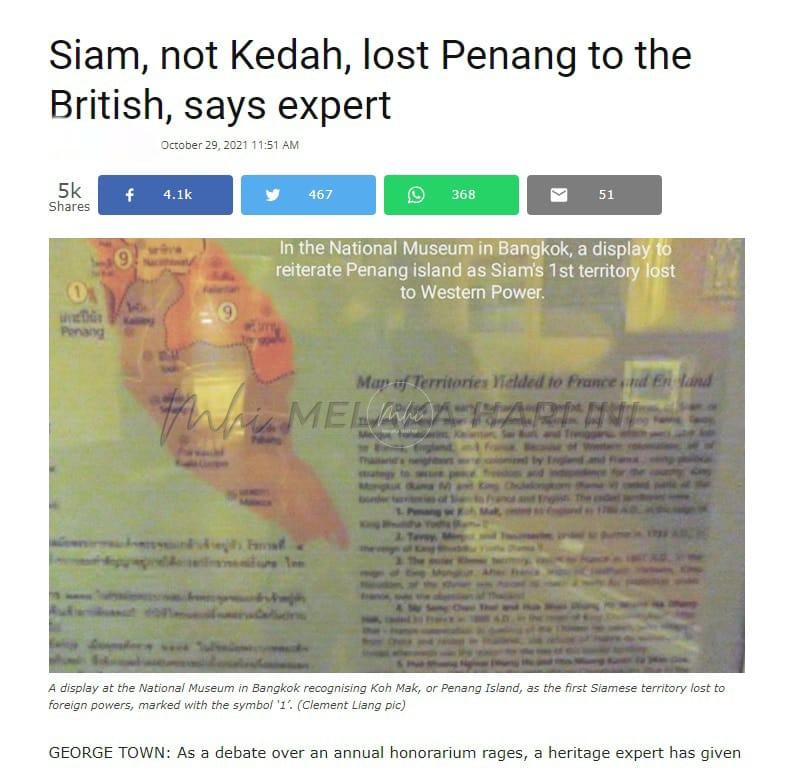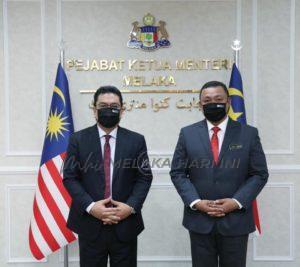
Writing Kedah History: A Shameful Belief Toward Thailand’s Chauvinistic Nationalism
SOMETHING is gravely wrong on Pulau Pinang’s argument and belief on the history of Kedah. An alternative narrative no doubt. Nobody is prohibiting the expression of alternative views and perspectives. Even in a history department, the history of a subject can/would differ from one historian to another based on one’s bias. This could be determined by things like ethnicity, geography, class, national interest, etc. We call it pluralism. Tolerating different views.
Under certain circumstances, this writing and interpretation of history can be problematic. Historiography is indeed contentious. Recent views on Kedah history are just incredible. Vassal state or not, from earlier on, and through the 1700s Pulau Pinang is/was an island of Kedah. Period.
Pulau Pinang was/is like Pulau Langkawi – de facto and de jure a Kedah island, at least until 1791. Suddenly Pulau Pinang appears to produce a bunch of selective history pundits with perhaps more of a belief, that Pulau Pinang since time immemorial was never a Kedah island. This seems to be the early beginnings of an ideology coming from a member of the custodian of the state’s history and heritage. In Siam/Thailand the likes of those views would be called seditious history.
Recently, Council Member of the Penang Heritage Trust (PHT) Clement Liang’s statements have done much harm to Kedah and the nation. An online news portal (29 October, 2021) cited him as saying that it was Siam, not Kedah, that lost Penang to the British. He subscribes to the Thai narrative and sources to justify the belief, among others, that Pulau Pinang was integral to the Kedah Sultanate. This has ramifications on the sovereignty of Kedah. It is perplexing.
It seems that all this while, the Pulau Pinang establishment harbours a Thai/colonial-centric view of things. If Clement were a Siamese a century ago writing Thai/Siamese history from sources not sanctioned by the Thai king and his council, he would have been punished. But this is Malaysia. No punitive action for falling on the wrong side of history, nor claiming alternative narratives. But they can go read Seditious Histories: Contesting Thai and Southeast Asian Pasts by Craig J. Reynolds (2006).
The many factors in Kedah history are not as simple as it seems. These are intricate. In the process, there are also ‘retrospective narratives’ by scholars and historians, jurists and judges over the last 200 years on Pulau Pinang viz Kedah. Academic writings, and popular commentaries on history do display peculiar tones of representation, and varying subtexts.
Sure, we cannot avoid problems of bias. But the nation’s history, and that of Kedah/Pulau Pinang must be revised. In the case of Kedah/Pulau Pinang, we would generally agree on the sovereignty of Kedah. To assert that it was Siam that lost Pulau Pinang, and not Kedah is strange. Granted that the views are representative of PHT, and that the heritage body is offering an alternative interpretation on Kedah, by itself go ahead. Nobody is prohibiting alternative histories on Kedah and Malaysia. This a free country on the writing of history. Much freer than Thailand, or Japan or China. Alternative histories are welcome.
But the attempt at rewriting the history of Kedah (and the nation) is simply out of line. It seems that the Pulau Pinang establishment is unable to grapple with the complexities of the discourse.
It is not entirely incorrect to say that Kedah was a vassal state of Siam at certain times in history. But it is not correct to imply that Kedah does not have the sovereignty to conduct contracts and external relations with other parties. And it is absurd to rationalize that Pulau Pinang was never a part of the Sultanate.
The debate on Kedah by the PHT representative and the Pulau Pinang establishment does not hold water. Their subscribing to the Siamese narrative makes it even more untenable. The Siamese could not comprehend the European notion boundaries, territoriality, state and sovereignty. This clarification comes from a Thai historian himself. Our historians seem to be oblivious.
Thongchai Winichakul, professor of Southeast Asian History at the University of Wisconsin-Madison, United States raises the position of the Siamese on the modern view of territorial sovereignty. I am mindful that Thongchai is Thai. When Kedah failed to pay tributes as scheduled, Siamese forces mounted several invasions to pressure them to pay up. He said most of the invasions were merely a show of military force by the Siamese, without an actual battle as Kedah gave in. Siam had also expected loyalty by the sultan.
Thongchai refers to the use of maps, as for example the one displayed at the Thai National Museum in Bangkok carried by the news portal (with the photo courtesy of Clement Liang) showing the Malay peninsula. The map illustrates what Thongchai refers to by the “chauvinistic nationalism” of Thailand. The Thai attitude does not serve for a better understanding of history, from both sides of the ASEAN member states.
This shows the Thai attitude as anachronistic, generated by a bogus interpretation of history. According to Thongchai, Thailand has been using them as propaganda for decades. And a party of the Malaysian citizenry succumbed to that propaganda led by a belief which is by itself prejudiced and chauvinistic toward Kedah and national history.
Langgani saluran Telegram kami untuk dapatkan berita-berita yang terkini.


